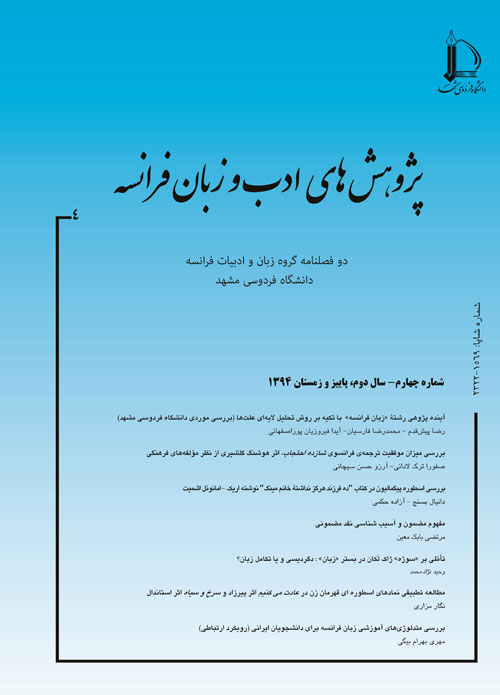Contrastive Study of the Mythical Symbols of Heroines in We are accustomed to & Red and Black written by Pirzad & Stendhal
Author(s):
Abstract:
The mythical symbols are the reflection of spiritual needs of human beings. Indeed, the symbol is the mythical language. In the 20th century, the anthropological researches conducted by Gilbert Durand, have assisted in recognition and understanding of its symbolic meanings. On the other hand, attention paid to myth by psychoanalysts and their research about the meaning of symbols have opened another window for researching and recognizing mythical themes. From the Freuds point of view, myth is the indicator of mental tensions emerged from the unconsciousness of humans. From Jungs point of view, the mythical themes are rooted in the collective unconsciousness of human beings; therefore, if we recognize archetypal meanings, we have achieved collective unconsciousness. Jung believes that any artistic and literary creation is originated in ancient myths and is the manifestation of the mental condition and spiritual needs of the human beings. Benefiting from his analytical psychology and studying the masculine and feminine element and its influence on ancient pattern dominant on the psyche of humans, he studies the personality of humans. In the present research paper, the goddesses embedded in the heroines of two works entitled We are accustomed to & Red and Black written by Pirzad & Stendhal will be studied. The goddesses who form the psychological structure of the heroines of these two works as a pattern will be analyzed. We will benefit from the Jungs archetypal ancient psychological theories for recognition of the cultural forms and the community from which the heroines have been emerged. The study of goddesses and ancient patterns dominant on the psyche of the heroines will help us in understanding the internal motivations of the characters. The result of the present study will pave a way for recognizing the behavioral models of the eastern and western communities.
Language:
Persian
Published:
Research Literature of French, Volume:2 Issue: 4, 2016
Pages:
121 to 139
magiran.com/p1686980
دانلود و مطالعه متن این مقاله با یکی از روشهای زیر امکان پذیر است:
اشتراک شخصی
با عضویت و پرداخت آنلاین حق اشتراک یکساله به مبلغ 1,390,000ريال میتوانید 70 عنوان مطلب دانلود کنید!
اشتراک سازمانی
به کتابخانه دانشگاه یا محل کار خود پیشنهاد کنید تا اشتراک سازمانی این پایگاه را برای دسترسی نامحدود همه کاربران به متن مطالب تهیه نمایند!
توجه!
- حق عضویت دریافتی صرف حمایت از نشریات عضو و نگهداری، تکمیل و توسعه مگیران میشود.
- پرداخت حق اشتراک و دانلود مقالات اجازه بازنشر آن در سایر رسانههای چاپی و دیجیتال را به کاربر نمیدهد.
دسترسی سراسری کاربران دانشگاه پیام نور!
اعضای هیئت علمی و دانشجویان دانشگاه پیام نور در سراسر کشور، در صورت ثبت نام با ایمیل دانشگاهی، تا پایان فروردین ماه 1403 به مقالات سایت دسترسی خواهند داشت!
In order to view content subscription is required
Personal subscription
Subscribe magiran.com for 70 € euros via PayPal and download 70 articles during a year.
Organization subscription
Please contact us to subscribe your university or library for unlimited access!



